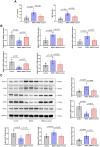Luteolin targets the AGE-RAGE signaling to mitigate inflammation and ferroptosis in chronic atrophic gastritis
- PMID: 38917486
- PMCID: PMC11272119
- DOI: 10.18632/aging.205969
Luteolin targets the AGE-RAGE signaling to mitigate inflammation and ferroptosis in chronic atrophic gastritis
Abstract
Chronic atrophic gastritis (CAG) is a chronic inflammatory disease and precancerous lesion in stomach cancer. Abnormal activation cellular ferroptosis further damages gastric tissue, which is susceptible to inflammation. Luteolin has powerful anti-inflammatory and regulatory potential for cellular ferroptosis. We aimed to clarify the involvement of luteolin in inflammation and ferroptosis during CAG. Luteolin targets were searched to identify intersecting genes in the chronic atrophic gastritis disease database. The AGE-RAGE pathway is a potential target of luteolin for the treatment of chronic atrophic gastritis and a binding site between luteolin and RAGE was predicted through a computer simulation of molecular docking. We established a CAG rat model using N-methyl-N-nitro-N-nitroguanidine. The therapeutic effect of luteolin on CAG was detected using western blotting, qPCR, hematoxylin and eosin staining, lipid oxidation (MDA), and Fe2+ assays. Luteolin inhibited the AGE-RAGE signaling pathway and reduced the inflammatory response in gastric tissues. Additionally, luteolin downregulated the concentration of (MDA) and Fe2+, and CAG downregulated the expression levels of ACSL4 and NOX1 and upregulated the expression levels of FIH1 and GPX4 ferroptosis-related proteins, thus inhibiting the ferroptosis of gastric tissue cells, which had a therapeutic effect on CAG.
Keywords: AGE-RAGE signaling pathway; chronic atrophic gastritis; ferroptosis; luteolin.
Conflict of interest statement
Figures






References
-
- Osmola M, Hemont C, Chapelle N, Vibet MA, Tougeron D, Moussata D, Lamarque D, Bigot-Corbel E, Masson D, Blin J, Leroy M, Josien R, Mosnier JF, et al.. Atrophic Gastritis and Autoimmunity: Results from a Prospective, Multicenter Study. Diagnostics (Basel). 2023; 13:1599. 10.3390/diagnostics13091599 - DOI - PMC - PubMed
MeSH terms
Substances
LinkOut - more resources
Full Text Sources

